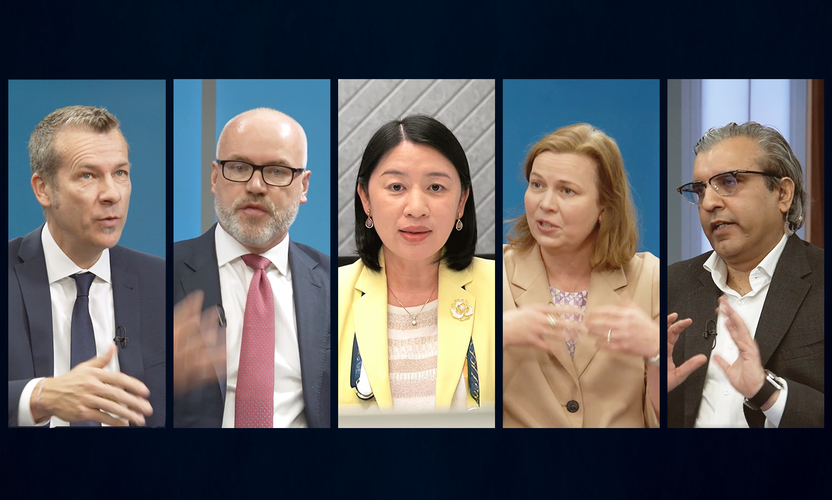President Trump recently predicted that he and President Xi Jinping would have a signing summit for a deal soon, but has also cautioned that an agreement ‘might not happen at all’.
As mixed messages proliferate, we believe it makes little sense for investors to try to anticipate the precise timeline of the outcome of these negotiations, or overreact to the latest tweet. Instead, our team is considering several key questions that will shape the negotiations and their outcome, and the potential implications for global markets.
Will additional Chinese purchases of US goods to reduce the bilateral deficit solve things?
Discussions so far have included the possibility of China re-directing some of its purchases from other global partners towards the US. This seems like an achievable step, and indeed something on which China is very keen to focus.
Of course, in reality, global trade is rarely that straightforward - and the practicalities of this shift will need to be worked through. Importantly, however, even large increases in Chinese purchases are unlikely to satisfy the hawks in the US administration. After all, China has been offering these for a long time now, and a deal has yet to be struck.
The US’s key negotiator, Robert Lighthizer, warned in February, “Don’t go for the soybean solution”. He was likely talking as much to China, warning them to also address more structural trade issues, as he was to President Trump, urging him not to be ‘bought off’ for a quick deal.
Can China’s domestic industries be opened up to US competition?
This question has weighed on US-China relations for a number of years.
While there are signs that China’s domestic industries are gradually opening up (for example, Beijing raising limits on foreign ownership for financial firms to 51 per cent, with the cap to be removed in three years), the progress so far has been slow. Just as important, tensions remain around perceptions of IP ‘theft’ and a generally unwelcoming environment for foreign firms.
It is likely that Beijing can open up several sectors, at least in legal terms, to foreign participation and ownership. This trend was in place already and is beneficial for China’s economy, with Chinese firms now developed and competitive enough to withstand US entrants.
This would not be hard for the US to monitor. More difficult are assurances around the ‘competitive neutrality’ of foreign firms with local participants, particularly state-owned enterprises, where concerns range from ease of obtaining permits, to unequal subsidies.
That said, even Chinese firms complain of an unlevel playing field with state owned enterprises (SOEs), and Beijing has shown some willingness to address this. Overall, the challenge is not insurmountable, but friction is nonetheless likely.
How does China’s structural economic model impact the conversation?
We see this as potentially the biggest deal-breaker. Many view China’s state-directed economy as being fundamentally at odds with the liberal international trade system. Everything from domestic subsidies, preferential policy bank lending and the prominence of state-owned enterprises are significant issues here.
The US is justifiably concerned that this makes it hard for foreign firms to compete fairly. Perhaps more importantly, the system arguably distorts price and profit incentives, which can lead to oversupply in key industries and thus harm even efficient and productive foreign trading partners.
In the past, this was evident in sectors like steel, with the concern that this could start to impact higher value-add areas, like semiconductors and renewable energy.
Many of the steps that would need to be taken appear to be non-starters for President Xi Jinping. China views a strong state, with significant involvement in industry, as critical for economic and political stability, as well as maintaining strong GDP growth. They see it as integral to its tremendous success in recent decades. Made in China 2025 is an example of how difficult these concerns are; this is an aggressive industrial policy in high-tech industries.
Against US pressure, all reference to this specific title disappeared in late 2018. However, the policies have, if anything, been intensified, as China views self-reliance and technological expertise as even more important goals in a hostile external environment.
What is the role of FX?
Currency is also likely to form part of any potential deal, and we see this as an area where the US and China’s long-term objectives are more naturally aligned.
While the US will be keen to avoid a depreciating Chinese yuan, currency stability is also clearly in China’s interest, in order to attract foreign flows as it makes efforts towards becoming a global reserve currency, as it opens up its economy and to reduce the risk of ongoing capital outflows.
Will China agree to measurable and enforceable steps, subject to US verification?
This is another difficult area for talks. US trade hawks perceive decades of false promises and China disobeying World Trade Organisation’s rulings, and so believe that any agreed steps need to be effectively enforced and monitored by the US.
China may view this as some combination of insulting, politically difficult, and an intolerable infringement on its sovereignty - and of course, it may simply wish to avoid complying with some aspects of the agreement, which effective enforcement would make more difficult.
For instance, Beijing may well promise, and even legislate for, tackling forced IP transfer. However, if local governments are ultimately not made to enforce it, or loopholes are found, the US wants to ensure it has recourse.
What does this all mean for investors?
Ultimately, while headlines suggest that the US and China are inching closer to a deal, it’s clear that there are still a range of questions that need to be addressed.
Some of these are practical and achievable, others are more fundamental and challenging.
US trade hawks see China as fundamentally incompatible with the established global order. Some in Beijing see US actions as an unacceptable attempt to ‘contain’ China’s rise. President Trump may only see an important win ahead of next year’s elections that is almost within his grasp.
Trade negotiations are difficult, and tensions will remain for the foreseeable future. As such, we believe it’s important for investors not to chase trade-related euphoria, or lose sight of other fundamental drivers of growth and markets.
We would suggest that China has really been fighting two wars with the US - one on trade, and one on Federal policy - both of which hurt the Chinese economy and markets last year.
Looking forward, the main question for investors is perhaps not about the precise timing or wording of any overall deal, but about how the process develops - and if China manages to keep the tail risk of significant tariff escalation off the market’s mind.
Over the coming months, easing conditions on trade and US monetary policy should help China’s ongoing effort to stimulate its economy and sustain long-term growth.
President Trump flying all the way to Hanoi, only to end his summit with Kim Jong Un early and without a deal, is a timely reminder of how events and sentiment can change suddenly and unexpectedly.
As such, investors should avoid positioning portfolios with one specific trade war outcome in mind, but remain diversified across global regions and asset classes. A flexible investment approach and broad toolkit will be key to capturing opportunities and mitigating risk as the situation develops.







































